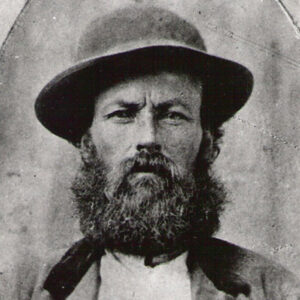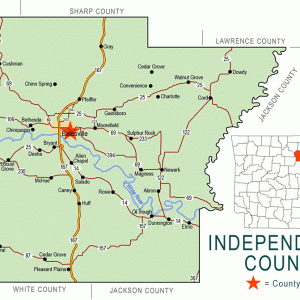calsfoundation@cals.org
Starnes Spring (Independence County)
Isolated in the middle of a wooded area in Relief Township in Independence County, Starnes Spring lies between Floral (Independence County), which is four and a half miles to the south, and Concord (Cleburne County), about four miles to the west. At one time, there was a road that cut across to Jamestown Mountain from the spring, but it later closed. The water from the spring flows into nearby Caney Creek. Picturesque Bailey’s Falls (a.k.a. Bailey’s Pour Off) and an unusual geological rock formation called the Devil’s Tea Table (both currently restricted areas on private land) are within a few miles of Starnes Spring, as is Camp Tahkodah, a ten-acre Church of Christ camp on the banks of Salado Creek owned by Harding University in Searcy (White County). The old Starnes Spring Cemetery is all that remains of the Starnes Spring community.
The first white settler known to have settled in the area was John W. Starnes from Haywood County, North Carolina. He also discovered the spring. After his widowed mother’s death in 1850 in Meigs County, Tennessee, Starnes moved to Independence County and was, by the 1860 census, living in Liberty Township (where Starnes Spring was located at that time), with his wife, Elizabeth Chapman Starnes, and their son, James S. P. Starnes.
This wilderness area in the years following the Civil War beckoned more settlers, with the chief attraction being the spring, which provided a dependable source of water for the community. Starnes Spring was home to physician Martin Van Buren Busby. Dr. Busby was born in Alabama and married a widow, Mary Elizabeth Myrick, in Johnson County, Illinois, in 1859. The couple and their children settled in Starnes Spring shortly after the Civil War, where Dr. Busby established a successful practice. He died in 1880 while treating patients during a typhoid epidemic.
The rugged landscapes of Jamestown, Brock, and Hutchinson mountains around Starnes Springs were famous as hiding places for outlaws and fugitives.
The tombstones in the Starnes Spring Cemetery bear the names of the families who lived in the community during its heyday from the post–Civil War years until the end of World War I: Allison, Alsup, Bullard, Busby, Dean, Fredeking, Green, Jackson, Myrick, Shipley, Rachels, Romig, and Thomas.
Calvin Bynum Green Jr. and his first wife, Melissa M. Downey, arrived in Starnes Spring after the Civil War from Mississippi. Their daughter, Willie Etta (Etter) Green, married William Frederick (Bill) Graddy (or Grady), who became postmaster of Hutchinson Mountain in 1905, and together they operated a general store with the post office. Both are buried in Starnes Spring Cemetery, as is Etta’s sister Viola.
Farming was not easy in the hilly soil, but small grain crops were common, and often corn was used in the making of moonshine. A few moonshine wars have taken place over the years around Starnes Spring when rival moonshiners encroached on each other’s territory.
The Alsup brothers from Douglas County, Missouri, fought for the Union and found it difficult to get along with neighbors who had fought for the Confederacy. In 1881, the Springfield Times-Leader published editorials and news items against the Alsup family, maintaining that the name Alsup had “become notorious throughout southern Missouri and northern Arkansas.” The editorials accused the Alsup brothers of continuing the war against the Confederates. One of the brothers, Thomas Shelton (Shel) Alsup, who once served as sheriff of Douglas County, Missouri, was killed in an ambush in 1884.
The forefathers of the Alsup brothers raced thoroughbreds in Virginia, and family members were noted for their racing skills. A younger brother, William Wiley (Bill) Alsup, ended up in Starnes Spring, where his second wife, Bettie Bell Graham, lived. He was appointed postmaster when the post office was established in 1914. The post office was part of the Alsup general store. After his death in 1919, his wife served as postmaster until the post office closed in 1921. William Wiley Alsup is buried in Starnes Spring Cemetery. Jerry Alsup, a descendant, restored William Wiley Alsup’s gravestone after he found the broken stone in a cow pasture.
The Starnes Spring school, called Friendship School, was established in the early 1900s near the post office. The school merged with the Floral School District in the 1940s. The poultry industry, beginning in the 1940s and 1950s, led to chicken houses being constructed in the area. Logging continues to be an important occupation in the hills around Starnes Spring, and a paper company owns land in the area.
The closest church to Starnes Spring today is the Pine Grove Church, but the Floral Baptist Church and New Bethel are nearby. The historic Mount Zion Church is approximately one mile to the west. The region is served by the Floral Fire Department. Those who live near the Starnes Spring Cemetery or who have relatives buried there have carried out cleaning and restoration efforts.
For additional information:
McGinnis, A. C. “A History of Independence County, Ark.” Special issue. Independence County Chronicle 17 (April 1976).
Monks, William. A History of Southern Missouri and Northern Arkansas: Being an Account of the Early Settlements, the Civil War, the Ku-Klux, and the Times of Peace. West Plains, MO: West Plains Journal Co., 1907.
Kenneth Rorie
Van Buren, Arkansas
 Shelton Alsup
Shelton Alsup  Friendship School
Friendship School  Independence County Map
Independence County Map  Starnes Spring School
Starnes Spring School 




Comments
No comments on this entry yet.